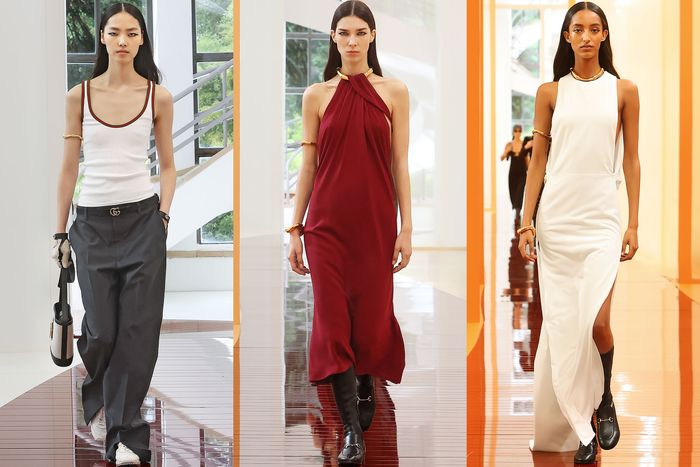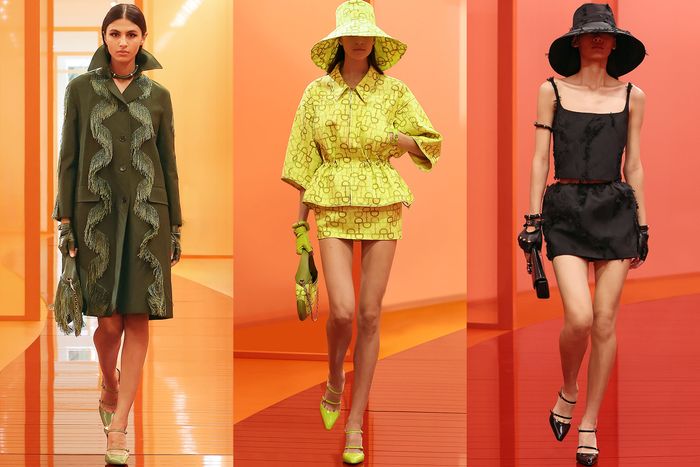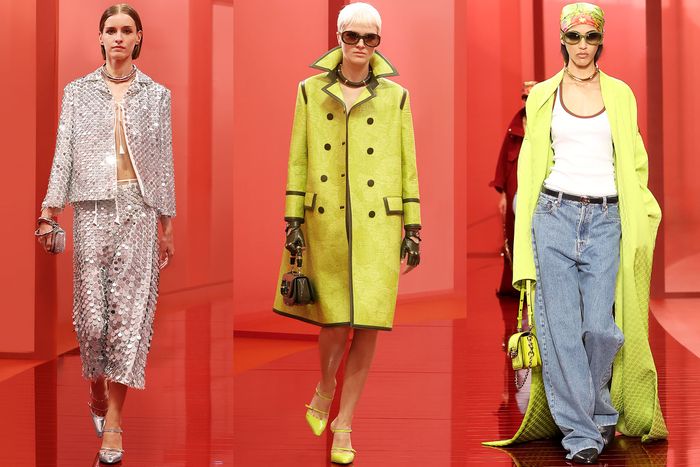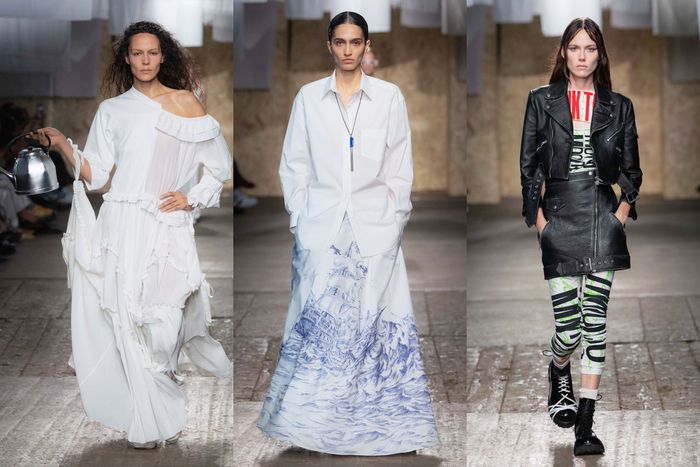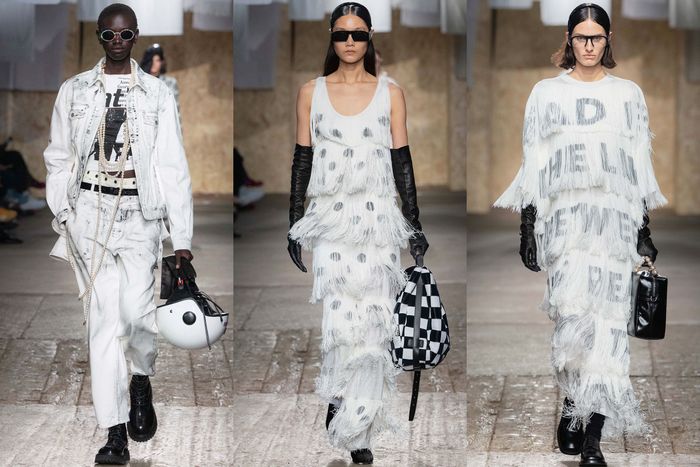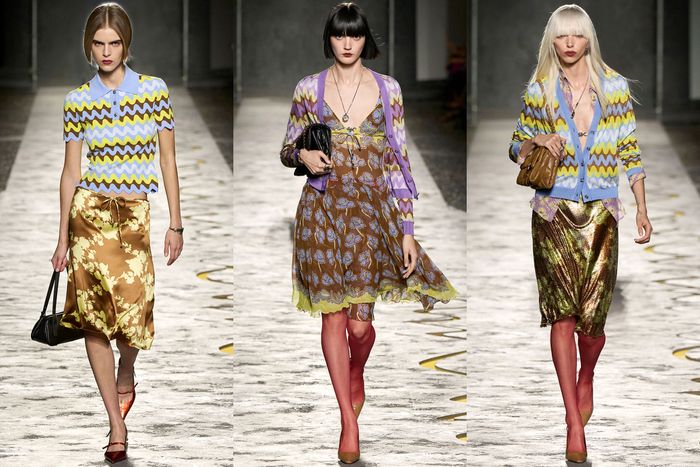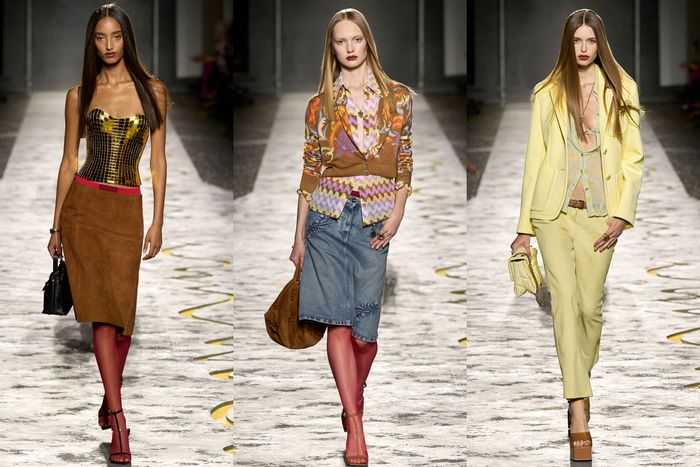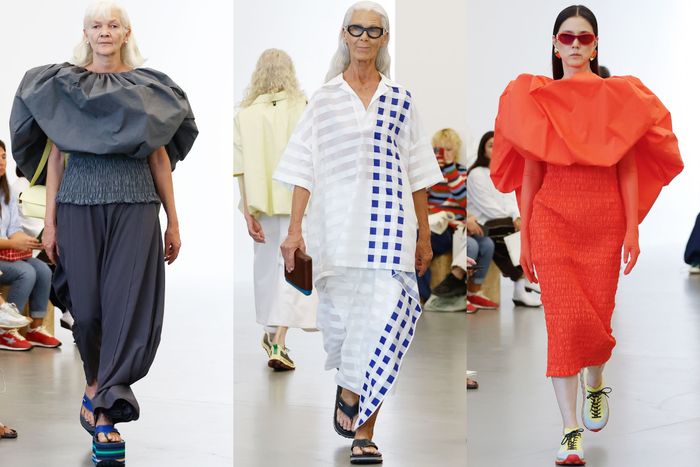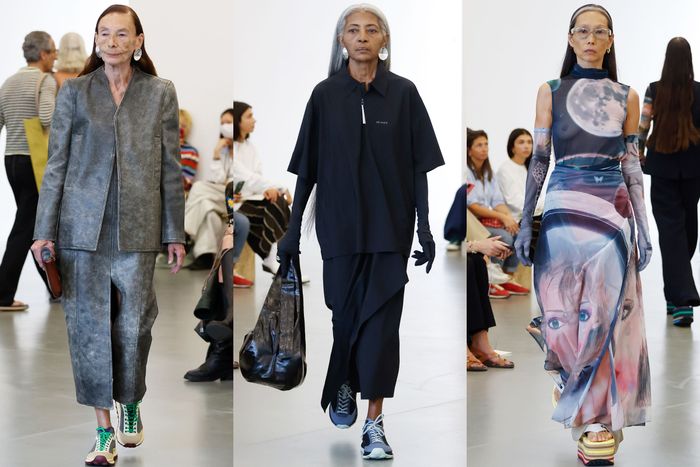Fashion
At Milan Fashion Week, (Mostly) Looking to the Past
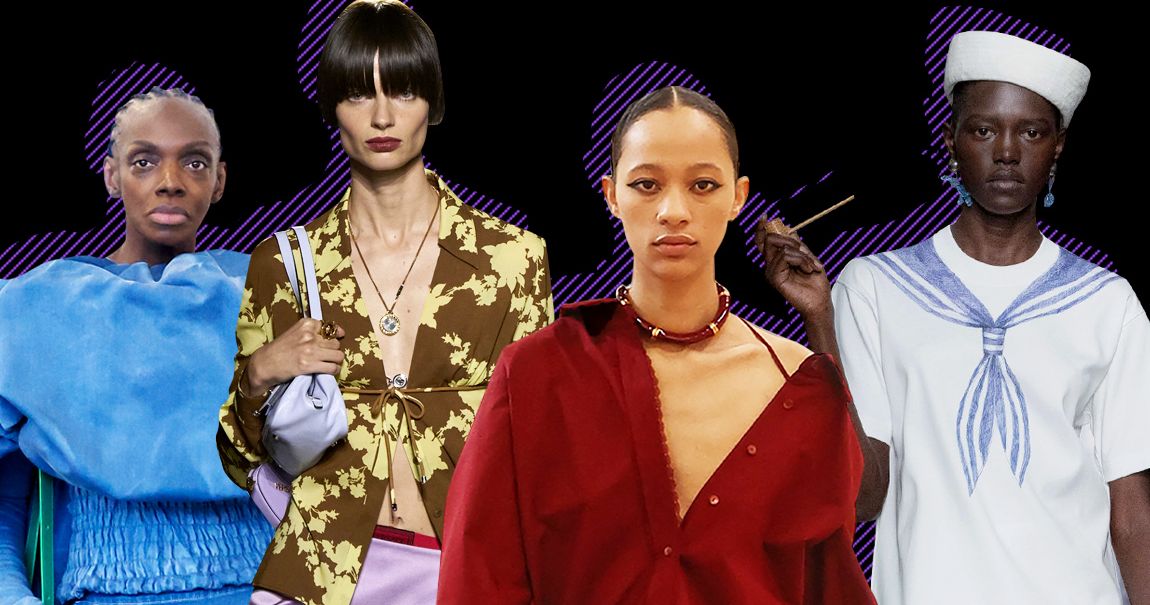
Photo-Illustration: by The Cut; Photos: Courtesy of Sunnei, Versace, Gucci, Moschino
“I love the past,” Sabato De Sarno said the other day in his studio in Gucci’s sprawling headquarters in Milan, known as the Hub. “Gucci is a big company but full of history; when I go to the archives in Florence, honestly, it’s one of my best days in the creative process.”
De Sarno stood next to a large board that displayed well-known images of Jackie Onassis and her sister Lee Radziwill dressed for an Italian summer in white slacks and T-shirts, silk headscarves framing their sunglasses. The collage of images included a 1988 cover of Italian Vogue, shot by Steven Meisel, of a fresh-faced model in a white cotton shirt by Gianfranco Ferre, with a headline declaring “Il Nuovo Stile.” De Sarno said, “This represented the contemporary.” In his collection, on Friday, he would have an oversized shirt in burgundy cotton worn with slouchy pants; many of the models wore print scarves and oversized glasses, and he reprised a boxy double-breasted coat that was part of the “Jackie look,” using now a blend of raffia and cotton in vivid lime green.
One can hardly fault designers for looking at the past since many of their famous predecessors did the same. Yves Saint Laurent liked the 1940s. Tom Ford used the mythology of the 70s and Halston to remake Gucci in the mid-90s, and his successor, Alessandro Michele, was an adept time traveler. This season, Prada acknowledged the influence of vintage clothes in the style of young women’s lives by tellingly including pieces with a Mod flavor. And other styles referenced early Prada. This week in Milan, there have been long lines for a new exhibition, “60 Years of Vogue Italia,” curated by the art director Ferdinando Verderi. The legendary editor Franca Sozzani, who died in 2016, ran Vogue for nearly half those years.
Gucci
Photo: Courtesy of Gucci
It could be that people just want to see brilliant design during one of Italy’s cultural heydays, when “the new style” was genuinely new and extended to photography and art direction. Yet, as many older brands became spectacularly successful — Gucci, for one — the luxury groups that own them have turned away from daring new designs and instead are offering merely tokens of novel. They apparently feel more confident about marketing and selling heritage — Jackie in Capri. Nearly all the bags and silk prints in the spring 2025 Gucci collection are either updates of classics, like the bamboo-handle bag (now done in various materials or with limited-edition artwork) or they’re exact copies. And it’s far from clear that this strategy will pay off. Gucci has seen a large revenue drop.
Gucci
Photo: Courtesy of Gucci
This was De Sarno’s third major show since he became creative director, and the clothes and visuals — a snaking, sunset-colored runway built at considerable expense in the Triennale museum — were moderately better. He still stuck with his salable, now predictable colors — grays, black, vino-reds perked up with lime and poppy — and his relaxed, well-done tailoring. The real visual surprise came from a series of mini puffball skirts with cropped jackets or a cool Henley shirt with satin cuffs and color. His final styles — white tank tops with faded, baggy jeans and oversized GG-monogram coats that carelessly swept the floor — seemed lazily aimed at younger customers.
Gucci
Photo: Courtesy of Gucci
My problem with De Sarno’s design is that he doesn’t seem to have an image of a woman in mind — the way, say, that Phoebe Philo so clearly does. Or his predecessors at Gucci did. Maybe current management doesn’t want that, or doesn’t know what it wants and is trusting heritage to lift Gucci’s boat. But if the history of fashion over the past 40 years has shown us anything, it is that that plan is a poor one. Look at the success of Hedi Slimane at Saint Laurent and Celine; Demna at Balenciaga, the prime example of radical and exciting transformation. Or Martin Margiela at Hermes in the late 90s, work that continues to inform other designers’ work. Prada is a big company, too, and yet Miuccia Prada and Raf Simons were right and bold to shake things up.
Other designers this week were also taking tokens of novelty, among them Moschino’s Adrian Appiolaza who drew on archival styles and blended them with graphic designs by Terry Jones, a founder of the influential London magazine, i-D. In a collection that felt as droopy as the laundry hanging over our heads, the best bits were long, art-printed t-shirts, including one that said “Get Happy,” veiled in white fringe.
Moschino
Photo: Courtesy of Moschino
Moschino
Photo: Courtesy of Moschino
Donatella Versace also looked back, though her collection was fresher than it has been in a while, thanks to a frisky blend of zig-zag striped knits with silk prints and cool, close-fitting pantsuits.
Versace
Photo: Courtesy of Versace
Versace
Photo: Courtesy of Versace
It’s puzzling to me that Italian designers, who really know how to play in summer, can’t manage to design summer clothes. Instead, they feel this need, or pressure, to “elevate” everything. It’s the stupidest word around, and in fashion, it results in a strange amount of faux-glam clothes that look dressy, itchy and uncomfortable, like Sportmax’s slinky beige tube dresses and tight pantsuits, most poised on high wedge heels. Really? This is summer?
No one in Milan quite grasped the feeling of summer like Simone Rizzo and Loris Messina, the designers of Sunnei, who presented their remarkable collection on Friday evening in a spacious art gallery. The irreverent brand celebrated its 10th anniversary, and as Rizzo and Messina said, “Ten years feels like one hundred.” Being an independent designer can wear you down.
Sunnei
Photo: Courtesy of Sunnei
Not that any stress showed. Rizzo and Messina presented the collection of 30 looks on older men and women, all strikingly elegant looking and dignified as they walked around the room. As the photographer Juergen Teller said afterward, “I almost wasn’t looking at the clothes because the faces were so beautiful. But so were the clothes!”
Sunnei
Photo: Courtesy of Sunnei
Indeed. It felt like summer had finally arrived at the collections. Messina and Rizzo have a knack for turning simple things, like a blue-striped, mid-calf t-shirt or a pair of soft cotton pants gathered in pleats at the ankles, into a compelling way of dressing. Their intentions are sincere and the results are increasingly sophisticated — for example, a cotton top with a playful, exploding volume of fabric around the shoulders or a lovely, loose shirt and matching white mid-skirt printed with checks that seem to fade out. Some jersey styles included prints of women’s faces taken from artwork that Messina’s mother, Marylene Fantoni, did in the 80s.
“This is the first season that we one-hundred percent enjoyed the full process, the first time in 10 years,” Rizzo said, after greeting the artist Marina Abramovic. “And it’s great. I loved this collection. Because we don’t care about the future, we don’t care about the past. We just want to live the moment.”
That kind of thinking is so rare, and their wit and talent so explosive, that Messina and Rizzo deserve to be at a bigger house. They are almost hiding in plain sight.

